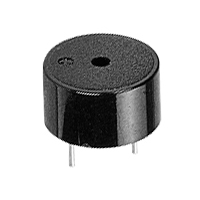Sorry about this one, you might find it a bit difficult to digest at first, and I didn't realise it's actually harder than it sounds. Anyway, spend some time on the code, let me know if you have problem understanding the code, or you have a better solution.
In this project, we will be using a low power speaker called Peizo speaker (around 8 ohm) that look like this:

This program basically changes states as the button is pressed, between OFF, TONE1 and TONE2. This is the circuit diagram:
One thing we need to aware of in this project before we do any programming, is that, we will need to create a header file to store all the pitches as sensible names that we can use directly. Let's create a new tap in the Arduino programming software:
And name it as "pitches.h". Copy and save the following:
#define NOTE_B0 31 #define NOTE_C1 33 #define NOTE_CS1 35 #define NOTE_D1 37 #define NOTE_DS1 39 #define NOTE_E1 41 #define NOTE_F1 44 #define NOTE_FS1 46 #define NOTE_G1 49 #define NOTE_GS1 52 #define NOTE_A1 55 #define NOTE_AS1 58 #define NOTE_B1 62 #define NOTE_C2 65 #define NOTE_CS2 69 #define NOTE_D2 73 #define NOTE_DS2 78 #define NOTE_E2 82 #define NOTE_F2 87 #define NOTE_FS2 93 #define NOTE_G2 98 #define NOTE_GS2 104 #define NOTE_A2 110 #define NOTE_AS2 117 #define NOTE_B2 123 #define NOTE_C3 131 #define NOTE_CS3 139 #define NOTE_D3 147 #define NOTE_DS3 156 #define NOTE_E3 165 #define NOTE_F3 175 #define NOTE_FS3 185 #define NOTE_G3 196 #define NOTE_GS3 208 #define NOTE_A3 220 #define NOTE_AS3 233 #define NOTE_B3 247 #define NOTE_C4 262 #define NOTE_CS4 277 #define NOTE_D4 294 #define NOTE_DS4 311 #define NOTE_E4 330 #define NOTE_F4 349 #define NOTE_FS4 370 #define NOTE_G4 392 #define NOTE_GS4 415 #define NOTE_A4 440 #define NOTE_AS4 466 #define NOTE_B4 494 #define NOTE_C5 523 #define NOTE_CS5 554 #define NOTE_D5 587 #define NOTE_DS5 622 #define NOTE_E5 659 #define NOTE_F5 698 #define NOTE_FS5 740 #define NOTE_G5 784 #define NOTE_GS5 831 #define NOTE_A5 880 #define NOTE_AS5 932 #define NOTE_B5 988 #define NOTE_C6 1047 #define NOTE_CS6 1109 #define NOTE_D6 1175 #define NOTE_DS6 1245 #define NOTE_E6 1319 #define NOTE_F6 1397 #define NOTE_FS6 1480 #define NOTE_G6 1568 #define NOTE_GS6 1661 #define NOTE_A6 1760 #define NOTE_AS6 1865 #define NOTE_B6 1976 #define NOTE_C7 2093 #define NOTE_CS7 2217 #define NOTE_D7 2349 #define NOTE_DS7 2489 #define NOTE_E7 2637 #define NOTE_F7 2794 #define NOTE_FS7 2960 #define NOTE_G7 3136 #define NOTE_GS7 3322 #define NOTE_A7 3520 #define NOTE_AS7 3729 #define NOTE_B7 3951 #define NOTE_C8 4186 #define NOTE_CS8 4435 #define NOTE_D8 4699 #define NOTE_DS8 4978 |
Here is the code, notice we have to include the line "#include "pitches.h" to use our pitches names.
| /* play sounds on a Piezo speaker. oscar's project Every time button is pressed, it moves to the next state. The states are: Off - On(Note-C2) - On(Note-D3) - Off - ... */ #include "pitches.h" int buttonPin = 1; // button input pin int speakerPin = 2; // speaker output pin int buttonState = 0; int beingPressed = 0; int state = 0; // 0, 1, 2 // notes to play int notes[] = { NOTE_C2, NOTE_D3 }; void setup() { // initialize the LED pin as an output: pinMode(buttonPin, INPUT); } void loop() { // read the state of the pushbutton value: buttonState = digitalRead(buttonPin); if (buttonState == HIGH){ // this is only true for once after button is pressed if (beingPressed == LOW){ if (state >= 2) state = 0; else state++; } // this is the rising edge of the button signal beingPressed = HIGH; } else { // falling edge of the button signal if (beingPressed == HIGH) beingPressed = LOW; } if (state == 1) tone(speakerPin, notes[0], 10); // param.:(output pin, pitch, duration) else if (state == 2) tone(speakerPin, notes[1], 10); else ;// DO NOTHING // give delay to let controller finish 'tone' instruction (same duration as 'tone') delay(10); } |

